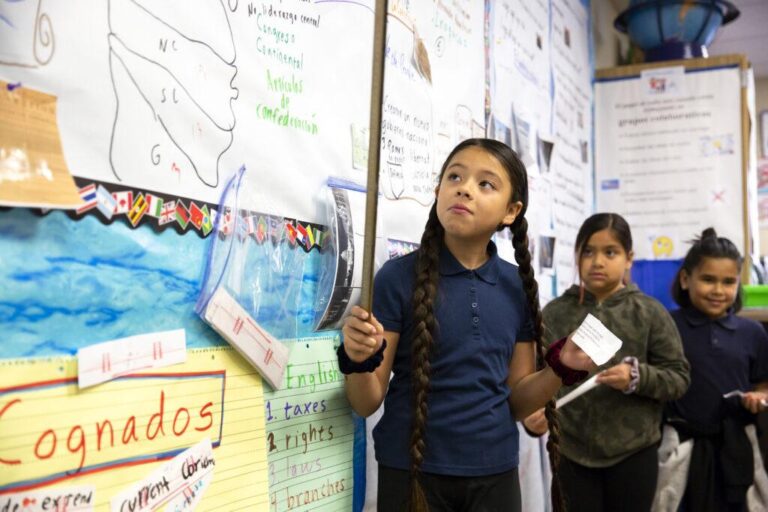After nearly two decades of restrictive policies curtailing bilingual education, California is embarking on a significant journey to rebuild and expand language programs in its public schools. The 18-year ban, rooted in a 1998 ballot initiative, had limited instruction primarily to English-only classrooms, affecting millions of English learners across the state. Now, as educators and policymakers rally to reverse years of setbacks, new legislation and renewed community support signal a pivotal shift toward embracing bilingualism and cultural diversity in education. This article examines the historical context, challenges, and promising developments shaping the future of bilingual education in California.
California Schools Embrace Bilingual Programs to Address Language Gaps
Following nearly two decades of restrictions on bilingual education, California schools are actively restoring programs that embrace students’ native languages alongside English instruction. Educators and administrators are witnessing improved academic engagement and confidence among students who benefit from learning in a culturally affirming environment. This shift not only addresses the linguistic divides but also recognizes the value of multilingualism in todayŌĆÖs globalized world.
Districts are focusing on comprehensive support strategies, which include:
- Dual-language immersion programs that encourage fluency in both English and another language from an early age.
- Professional development for teachers to effectively manage classrooms with diverse language needs.
- Community involvement initiatives to connect families and schools in supporting multilingual learners.
| Program Type | Key Benefit | Enrollment Increase (Last 3 Years) |
|---|---|---|
| Dual-language Immersion | Balanced bilingualism | 45% |
| Heritage Language Support | Cultural connection | 32% |
| English Learner Acceleration | English proficiency | 50% |
Challenges Faced by Educators in Reviving Bilingual Instruction
One of the primary obstacles educators encounter is the scarcity of qualified bilingual teachers. After nearly two decades without formal bilingual programs in California schools, many districts face a critical shortage of instructors fluent in both English and students’ native languages. This shortage is compounded by a lack of professional development resources tailored specifically to the nuances of bilingual pedagogy. Educators are often tasked with designing curriculum from scratch or adapting English-based lesson plans, which can inadvertently hinder the cultural and linguistic richness these programs intend to foster.
In addition, administrative and community support remains uneven across districts. Resistance rooted in logistical concerns and misconceptions about bilingual educationŌĆÖs effectiveness often complicate implementation efforts. Schools must juggle multiple priorities ŌĆö from securing bilingual materials to balancing standardized testing pressures. The table below highlights key challenges reported by educators in recent surveys:
| Challenge | Description | Reported by (%) |
|---|---|---|
| Teacher Shortage | Not enough certified bilingual educators available | 68% |
| Curriculum Gaps | Limited bilingual instructional materials and resources | 54% |
| Community Resistance | Parents and local leaders skeptical of bilingual methods | 43% |
| Funding Constraints | Insufficient budget allocations for program development | 60% |
Community and Policy Support Critical for Sustaining Language Diversity
The revival of bilingual education in California schools hinges not only on legislative change but significantly on robust community engagement and proactive policy frameworks. Grassroots organizations, educators, and families are critical stakeholders, fostering environments where multilingualism is celebrated and sustained. Their efforts ensure that native languages are preserved, cultural identities strengthened, and students receive the cognitive and social benefits that bilingualism offers. This multi-layered support forms a vital backbone for effective language programs amidst an era of increasingly diverse student populations.
Policymakers must back these community-driven initiatives with clear directives and funding allocations that promote inclusivity and equity in education. Essential elements include:
- Comprehensive teacher training programs that equip educators with bilingual pedagogical skills.
- Updated curricula reflecting linguistic diversity and cultural relevance.
- Ongoing assessment tools to measure student progress across languages transparently.
Together, these components form a sustainable framework that not only rebuilds bilingual education but actively champions language diversity as a cornerstone of California’s educational landscape.
Recommendations for Effective Implementation and Long-Term Success
To ensure the successful revitalization of bilingual education programs, stakeholders must prioritize comprehensive teacher training that equips educators with culturally responsive methodologies and robust language instruction techniques. Additionally, establishing partnerships between schools and local communities is crucial to create a supportive environment that respects and celebrates linguistic diversity. Investment in updated curriculum materials that reflect studentsŌĆÖ cultural backgrounds and bilingual proficiency levels will also help foster engagement and improve academic outcomes.
- Ongoing professional development for educators
- Active community and parental involvement
- Access to authentic, bilingual instructional resources
- Regular program evaluations to monitor progress
- Collaborative policy support across districts
| Recommended Action | Expected Impact |
|---|---|
| Biannual teacher workshops | Enhanced pedagogical skills |
| Community language events | Increased cultural pride and engagement |
| State-funded bilingual resources | Improved access and equity |
| Annual program assessment | Data-driven improvement strategies |
Maintaining long-term success will depend heavily on sustained advocacy and funding at the state level, as well as fostering a climate where bilingualism is viewed as an asset rather than a barrier. Schools must cultivate ongoing dialogues with policymakers to secure the necessary resources and legislative support. Equally important is the creation of scalable models that can be adapted and replicated across diverse school districts, ensuring that bilingual education becomes an integral and permanent part of CaliforniaŌĆÖs public education landscape.
Insights and Conclusions
As California moves forward in restoring bilingual education after nearly two decades, the state faces both significant challenges and promising opportunities. Rebuilding these programs demands sustained commitment from educators, policymakers, and communities to ensure that language diversity becomes a cornerstone of the public school experience. The evolving landscape underscores a broader recognition of the value of bilingualismŌĆönot only as a tool for academic success but as a vital component of cultural identity and inclusion. As these efforts continue to take shape, CaliforniaŌĆÖs experience may serve as a pivotal model for other states reconsidering the role of bilingual education in fostering equitable and effective learning environments.







